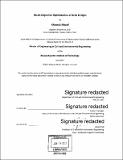| dc.contributor.advisor | Caitlin T. Mueller. | en_US |
| dc.contributor.author | Msaaf, Khaoula | en_US |
| dc.contributor.other | Massachusetts Institute of Technology. Department of Civil and Environmental Engineering. | en_US |
| dc.date.accessioned | 2017-09-15T15:37:46Z | |
| dc.date.available | 2017-09-15T15:37:46Z | |
| dc.date.copyright | 2017 | en_US |
| dc.date.issued | 2017 | en_US |
| dc.identifier.uri | http://hdl.handle.net/1721.1/111519 | |
| dc.description | Thesis: M. Eng., Massachusetts Institute of Technology, Department of Civil and Environmental Engineering, 2017. | en_US |
| dc.description | Cataloged from PDF version of thesis. | en_US |
| dc.description | Includes bibliographical references (pages 83-84). | en_US |
| dc.description.abstract | Trussed arch bridges are commonly used to attain big spans. They are efficient structures that offer a wide range of geometries, materials, and topologies. This thesis studies the influence of the geometry and topology of arch bridges on both their structural performance relayed by the maximum deflection and their structural weight. Various materials are also considered to calculate the embodied carbon emission and investigate the environmental impact of arch bridges. Gustave Eiffel's Garabit Viaduct is used as a design precedent for this study. 2-D and 3-D parametric models of the arch bridge are realized using Grasshopper [8]. Changing the geometric parameters in addition to the topology enables the investigation of the bridge's performance. The cross sections are automatically optimized in each case. Furthermore, a multi-objective optimization process was run on the bridge to examine the tradeoffs between the deflection and the self-weight. The weight-oriented optimization allows saving more than 60% of the weight compared to the original structure. Analyzing the different resulting designs proves that increasing the depth at the arch's crown and the depth at the base of the arch leads to better deflection results. It also demonstrates that using a denser truss structure leads to a lighter structure. | en_US |
| dc.description.statementofresponsibility | by Khaoula Msaaf. | en_US |
| dc.format.extent | 84 pages | en_US |
| dc.language.iso | eng | en_US |
| dc.publisher | Massachusetts Institute of Technology | en_US |
| dc.rights | MIT theses are protected by copyright. They may be viewed, downloaded, or printed from this source but further reproduction or distribution in any format is prohibited without written permission. | en_US |
| dc.rights.uri | http://dspace.mit.edu/handle/1721.1/7582 | en_US |
| dc.subject | Civil and Environmental Engineering. | en_US |
| dc.title | Multi-Objective optimization of arch bridges | en_US |
| dc.type | Thesis | en_US |
| dc.description.degree | M. Eng. | en_US |
| dc.contributor.department | Massachusetts Institute of Technology. Department of Civil and Environmental Engineering | |
| dc.identifier.oclc | 1003324294 | en_US |
